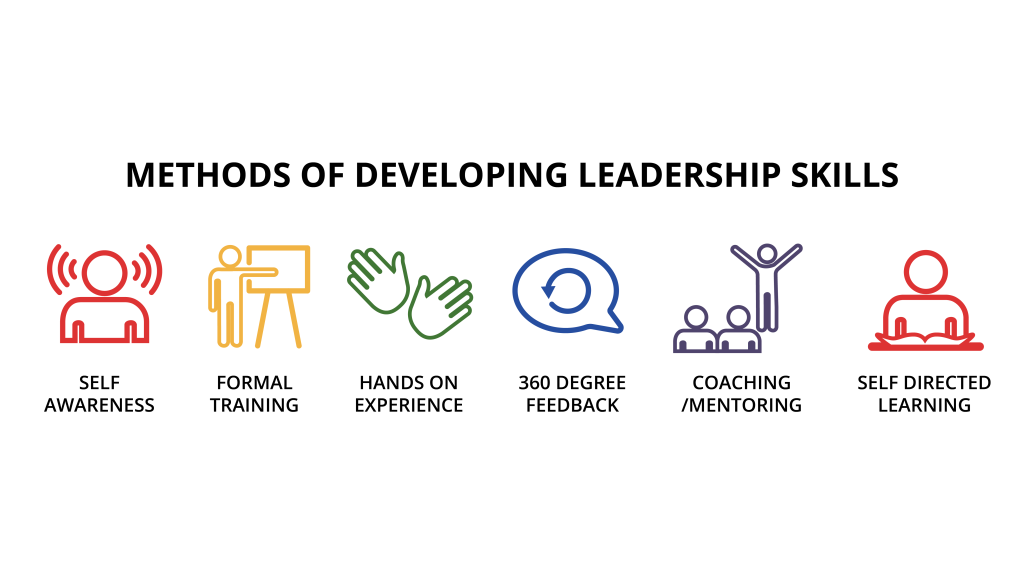2.10 Developing Leadership Skills
Methods of Developing Leadership Skills
When we think of developing leadership skills we can look at leader development (singular), as in developing our own personal ability to lead, or the ability of one individual in an organization. Leadership development (plural) looks at developing groups of individuals, for example, a training program set up in an organization to assist with succession planning, or for employees who are interested in moving into management roles. Leadership skills can be developed in through multiple mechanisms. Here we will look at self-awareness, formal instruction, hands-on experience, developmental coaching and mentoring, 360-degree feedback, and self-directed learning. Using a combination of approaches is most effective.

Self-Awareness
As discussed earlier, self-awareness is key to good leadership. Higher productivity and more satisfied followers may be correlated with leaders who are more self-aware (Moshavi et al., 2003).
Formal Training
Organizations often provide individuals with leadership development opportunities, however many larger entities build formal leadership development programs. Either way, conventional training increases knowledge and skills using coursework, practice, “overlearning” with rehearsals, and feedback (Kozlowski, 1998). This traditional lecture-based classroom training is useful, however, its limitations include the question of a leader’s ability to transfer the information from a training environment to a work setting.
Hands-on experience
Following formal training, organizations can assign leaders to jobs that target newly acquired skills. A job that helps to develop leadership is one in which employees learn, undergo personal change, and gain leadership skills resulting from the roles, responsibilities, and tasks involved in that job. Developmental job assignments are hands-on experience, and one of the most effective forms of leader development. A “stretch” or developmental assignment challenges leaders’ new skills and pushes them out of their comfort zone to operate in a more complex environment, one that involves new elements, problems, and dilemmas to resolve.
360-Degree Feedback
The 360-degree feedback approach allows leaders to maximize learning opportunities from their current assignment. It systematically provides leaders with perceptions of their performance from a full circle of viewpoints, including subordinates, peers, superiors, and the leader’s own self-assessment. With information coming from so many different sources, the messages may be contradictory and difficult to interpret. However, when several different sources concur on a similar perspective, whether a strength or weakness, the clarity of the message increases. For this mechanism to be effective, the leader must accept feedback and be open and willing to make changes. Coaching is an effective way to facilitate 360-degree feedback and help effect change using open discussion.
Developmental Relationships – Coaching and Mentoring
Leadership coaching focuses on enhancing the leader’s effectiveness, along with the effectiveness of the team and organization. It involves a structured, one-on-one relationship aimed at imparting important lessons through assessment, challenge, and support. Although the goal of coaching is sometimes to correct a fault, it is used more and more to help already successful leaders move to the next level of increased responsibilities and complex new challenges. Coaching aims to move leaders toward measurable goals that contribute to individual and organizational growth.
Mentoring is also a developmental relationship with individualized attention, however, it is often informal, unstructured, and may not be focused on specific tasks. Although some organizations do have formal mentoring programs, many individuals will seek out professional relationships with experienced leaders (inside or outside their institutions), to support them as they negotiate a new leadership landscape.
Self-directed Learning
Using self-directed learning, individual leaders teach themselves new skills by selecting areas for development, choosing learning avenues, and identifying resources. This type of development is a self-paced process that aims not only to acquire new skills but also to gain a broader perspective on leadership responsibilities and what it takes to succeed as a leader.
Leadership Skill Development Models
Van Veslor, McCauley and Ruderman (2010) described a two-part model for developing leaders. The first part identifies three elements that combine to make developmental experiences stronger: assessment, challenge, and support. Assessment lets leaders know where they stand in areas of strengths, current performance level, and developmental needs. Challenging experiences are ones that stretch leaders’ ability to work outside of their comfort zone, develop new skills and abilities, and provide important opportunities to learn. Support—which comes in the form of bosses, co-workers, friends, family, coaches, and mentors—enables leaders to handle the struggle of developing.
The second part of the leader-development model illustrates that the development process involves a variety of developmental experiences and the ability to learn from them. These experiences and the ability to learn also have an impact on each other: leaders with a high ability to learn from experience will seek out developmental experiences, and through these experiences, leaders increase their ability to learn.
The leader-development process is rooted in a particular leadership context, which includes elements such as age, culture, economic conditions, population gender, organizational purpose and mission, and business strategy. This environment molds the development process. Along with assessment, challenge, and support, leadership contexts are important aspects of leadership skill development models.
“Developing Leadership Skills” in Boundless Management by Boundless is licensed under a Creative Commons Attribution-ShareAlike 4.0 International License, except where otherwise noted.

